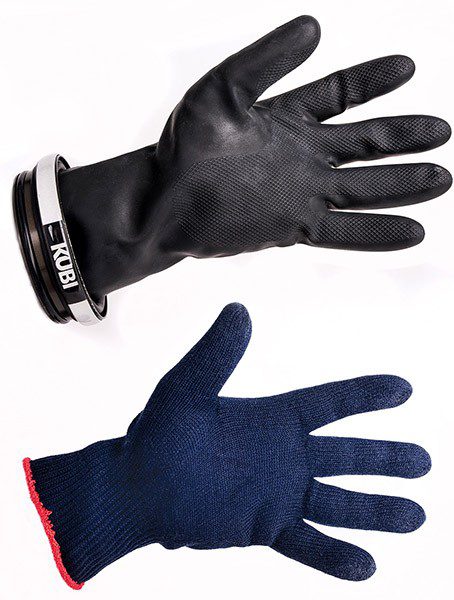HOWEVER COLD THE WINTER, it doesn’t necessarily mean that we have to pack our dive-gear away and wait for spring sunshine or a tropical holiday before it sees the light of day again.
We can still get wet and enjoy the advantages of coldwater diving, as long as we have the correct exposure protection.
Particularly vulnerable to frigid water temperatures are the hands. This month we share the results of a long-term test and a possible solution to the problem of freezing digits in the form of a dryglove system.

The Design
The Kubi dryglove system comprises two sets of aluminium rings, one for the exposure-suit cuff and one for the latex outer gloves. These marry together and are sealed with a series of large-diameter O-rings.
The rings are available in 70, 80, 90 and 100mm diameters with M (size 7.5), L (size 8.5), XL (size 9.5) and XXL (size 10.5) standard rubber, latex or textured latex outer gloves.
Insulating inner gloves are available in either Standard thermal, Sub Zero Factor 2, Merino wool or Alpaca in sizes from S to XL. There is also a zipped bag to store the inner and outer glove.
The system can be retrofitted to the cuffs of virtually any standard trilaminate or neoprene exposure suit. I’m told that it’s a simple operation, although I haven’t been able to verify this because the system I’ve had on test was factory-fitted to a custom-made Neoprene drysuit.
Once the inner cuff-ring has been fitted, a male version with the outer glove installed simply pushes into the cuff-ring and is sealed via a substantial O-ring.
I can confirm that removing and replacing the outer glove from the glove ring is a simple operation, taking less than two minutes even with my ham-fisted approach.
In Use
The first consideration was how to allow the gloves to equalise as depth and pressure increased during the dives.
When I first took them for a South Coast scalloping excursion I didn’t have the confidence to permanently break the suit’s wrist-seals, aware as I was that if the glove system failed I would not only have wet, cold hands but could possibly end up with a flooded drysuit.
Without a way to balance pressure, the outer gloves compressed onto my hands at depth, though when the stretchy latex collapsed it still allowed unhindered movement and didn’t affect my dexterity. What I did experience, however, was a reduction in thermal protection as the insulating air gap diminished.
On subsequent dives and with newly found confidence in the Kubi ring system, I put the thermal under-gloves on before donning the suit and allowed the glove-cuffs to sit beneath the wrist-seals.
This allowed air to migrate slowly to and from the gloves on ascent and descent, relieving any compression or expansion as the depth changed.
The latex outer gloves are slender and stretchy, which allows for a full range of hand and finger movement. The thin(ish) pair of thermal under-gloves didn’t lessen that all-important “sense of touch”, and I found this extremely useful when handling complicated camera controls, or making adjustments to computer settings while under water.
Donning and doffing the gloves and locating the ring-seals is actually simpler than putting on normal wet gloves. This is because the outer gloves don’t stick to the skin as damp Neoprene gloves do, and permitted each individual digit to find its home at the end of its corresponding finger-pocket.
The latex outer gloves appeared a little flimsy at first glance so they didn’t fill me with confidence, which is why I didn’t have the bottle to compromise my drysuit wrist-seals on the initial dives.
However, I can report that after a series of UK wreck-dives, plus more dives scratching around sharp stones and gravel collecting scallops, the gloves proved to be more durable than I had anticipated.
Thicker rubber gloves are available from Kubi should the standard latex versions prove under-gunned for even more demanding underwater operations.
Conclusion
Kubi’s is the only dryglove system to use aluminium rings, and plastic rings can, I find, flex and break the seals, causing leaks. This is why I reckon the system is a winter-diving game-changer. Its robust construction, ease of use and versatility has placed it at the top of my list of must-have gear for coldwater diving.
SPECS
PRICE: Standard system with latex outer gloves £156. Thermal under-gloves £8-30
RING SIZES: 70, 80, 90 and 100mm
OUTER GLOVES: Rubber, latex, textured latex, in sizes M, L, XL, XXL
INNER GLOVES: Standard thermal, Sub Zero factor 2, Merino wool and Alpaca thermal
CONTACT: www.kubistore.com
DIVER GUIDE 10/10
Appeared in DIVER February 2017
